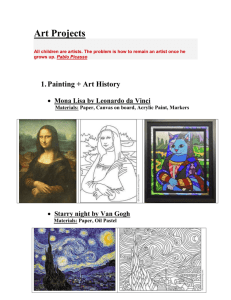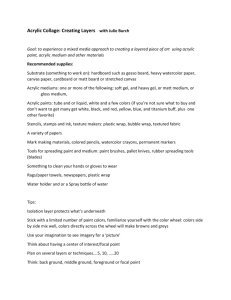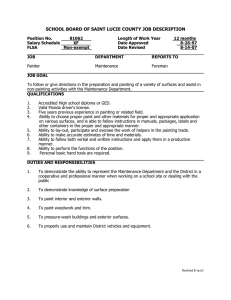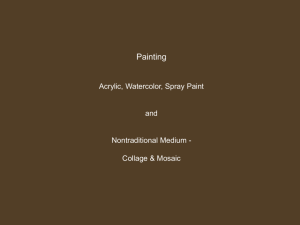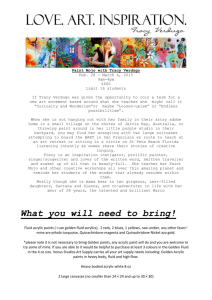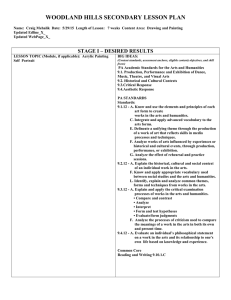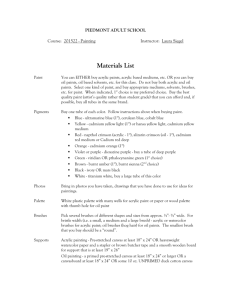Painting and Decorating
advertisement
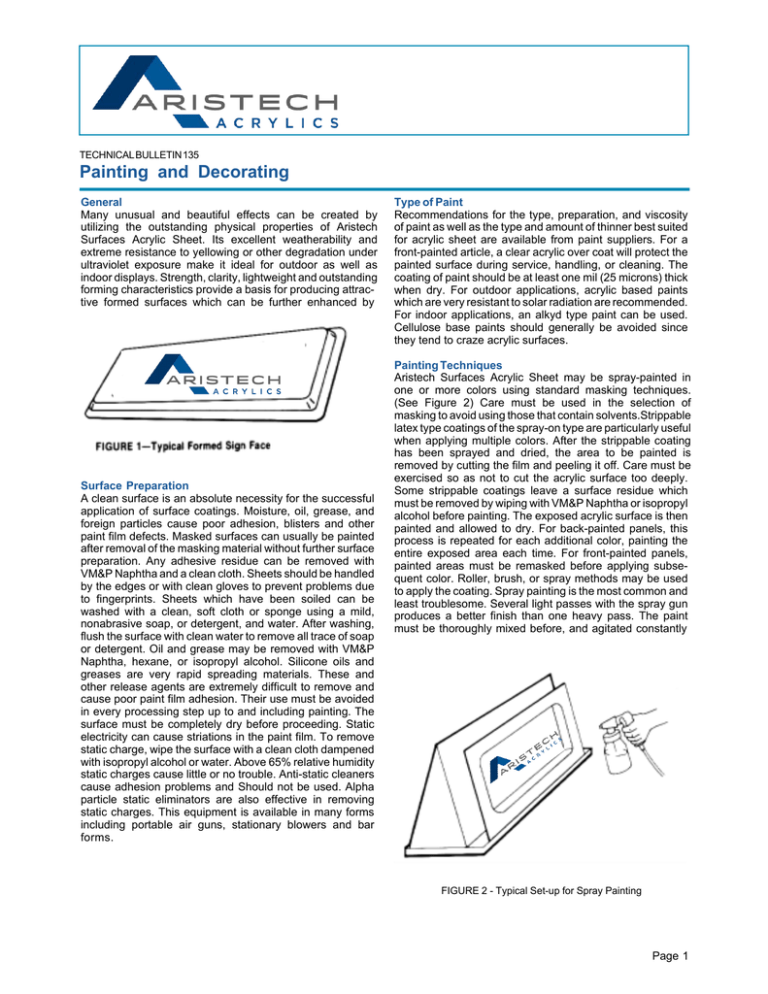
TECHNICAL BULLETIN 135 Painting and Decorating General Many unusual and beautiful effects can be created by utilizing the outstanding physical properties of Aristech Surfaces Acrylic Sheet. Its excellent weatherability and extreme resistance to yellowing or other degradation under ultraviolet exposure make it ideal for outdoor as well as indoor displays. Strength, clarity, lightweight and outstanding forming characteristics provide a basis for producing attractive formed surfaces which can be further enhanced by painting and decorating. (See Figure 1) Surface Preparation A clean surface is an absolute necessity for the successful application of surface coatings. Moisture, oil, grease, and foreign particles cause poor adhesion, blisters and other paint film defects. Masked surfaces can usually be painted after removal of the masking material without further surface preparation. Any adhesive residue can be removed with VM&P Naphtha and a clean cloth. Sheets should be handled by the edges or with clean gloves to prevent problems due to fingerprints. Sheets which have been soiled can be washed with a clean, soft cloth or sponge using a mild, nonabrasive soap, or detergent, and water. After washing, flush the surface with clean water to remove all trace of soap or detergent. Oil and grease may be removed with VM&P Naphtha, hexane, or isopropyl alcohol. Silicone oils and greases are very rapid spreading materials. These and other release agents are extremely difficult to remove and cause poor paint film adhesion. Their use must be avoided in every processing step up to and including painting. The surface must be completely dry before proceeding. Static electricity can cause striations in the paint film. To remove static charge, wipe the surface with a clean cloth dampened with isopropyl alcohol or water. Above 65% relative humidity static charges cause little or no trouble. Anti-static cleaners cause adhesion problems and Should not be used. Alpha particle static eliminators are also effective in removing static charges. This equipment is available in many forms including portable air guns, stationary blowers and bar forms. Type of Paint Recommendations for the type, preparation, and viscosity of paint as well as the type and amount of thinner best suited for acrylic sheet are available from paint suppliers. For a front-painted article, a clear acrylic over coat will protect the painted surface during service, handling, or cleaning. The coating of paint should be at least one mil (25 microns) thick when dry. For outdoor applications, acrylic based paints which are very resistant to solar radiation are recommended. For indoor applications, an alkyd type paint can be used. Cellulose base paints should generally be avoided since they tend to craze acrylic surfaces. Painting Techniques Aristech Surfaces Acrylic Sheet may be spray-painted in one or more colors using standard masking techniques. (See Figure 2) Care must be used in the selection of masking to avoid using those that contain solvents.Strippable latex type coatings of the spray-on type are particularly useful when applying multiple colors. After the strippable coating has been sprayed and dried, the area to be painted is removed by cutting the film and peeling it off. Care must be exercised so as not to cut the acrylic surface too deeply. Some strippable coatings leave a surface residue which must be removed by wiping with VM&P Naphtha or isopropyl alcohol before painting. The exposed acrylic surface is then painted and allowed to dry. For back-painted panels, this process is repeated for each additional color, painting the entire exposed area each time. For front-painted panels, painted areas must be remasked before applying subsequent color. Roller, brush, or spray methods may be used to apply the coating. Spray painting is the most common and least troublesome. Several light passes with the spray gun produces a better finish than one heavy pass. The paint must be thoroughly mixed before, and agitated constantly FIGURE 2 - Typical Set-up for Spray Painting Page 1 during application to prevent pigment settling. The viscosity of the spray paint must be kept constant from batch to batch. A Ford or a Zahn cup is used to measure this property. Because temperature affects viscosity, these measurements are commonly made at 73 °F (23 °C) . Follow the manufacturer’s directions carefully when using thinner. The wrong type or amount of thinner can cause serious film defects. Also check with the manufacturer when blending pigments, because two stable colors, when blended, may produce an unstable mixture. Spray Equipment Equipment suppliers such as Binks Manufacturing and De Vilbiss should be consulted for recommendations on the type and size of equipment best suited for a particular application. The compressed air must be clean and dry. Compressor capacity is determined by the type and number of spray guns to be used. Air pressure is normally 60 psi (4.2 kg/cm2). Air hose size (diameter) is determined by the allowable pressure drop. Both the gun and pressure pots should be equipped with metal strainers. Guns and strainers should be cleaned daily. Pressure pots and lines should be cleaned at least once a week. Paint spray booths should be explosion-proof with a ventilation system which conforms to the regulations of Underwriters’ Laboratories. For painting articles, such as signs, which are to be backlighted for display purposes, it is desirable to have facilities in the spray booth to back light during application. This will assure an even distribution of the coating. Paint Removal Commercial paint strippers of unknown composition should not be used for removing paint from Aristech Surfaces Acrylic Sheet because they can cause crazing, particularly of highly stressed areas. Cyclohexanone can be applied by wiping with a cloth (do not immerse) to remove the paint. Solvesso 100 (or equivalent) can be used similarly, or in an immersion process. Immersion time should be limited to not more than ten minutes, followed by wiping to remove the degraded film. It is advisable to anneal the part after stripping to remove solvent residue and to eliminate the possibility of crazing upon repainting. Soaking in a 15% solution of caustic soda or trisodium phosphate followed by thorough water rinsing can be used to remove nonacrylic paints or freshly-applied acrylic paints. These chemicals attack human skin and protective gloves should be worn when handling them. Paint may also be removed from Aristech Surfaces Acrylic Sheet by sand blasting with a fine grit. This method is more expensive than using solvents and leaves a frosted surface which can produce a grey tone when repainted with white paint. Silk Screening A silk screen technique is often used when multicolor decorations or designs are required. (See Figure 3) This technique uses stencils made from silk, nylon, or metal screens. Those stencils are made by coating the screens in the areas not to be painted with a glue filler or other nonporous material. The screening paint or lacquer is then forced through the open meshes of the screen onto the surface of the plastic by rolling a rubber squeegee over the screen with straight, back-and-forth strokes. The edges of the squeegee must be kept free of dried deposits of paint or lacquer to obtain the best results. A separate screen is used for each color with the mesh of each screen determined by the viscosity of the screening paint and by the desired density of the decoration. Screen patterns are usually handmade by an artist. A photographic process such as that developed by the Eastman Kodak Company for placing patterns on screens can also be used. Paints, lacquers, and inks formulated for silk screening acrylic plastics are available with instructions from the various paint companies. The silk screening technique finds wide use in the sign industry. Many signs of the same design can be rapidly decorated by this method. Silk screening equipment consists of three basic parts; a baseboard, a hinge bar and a printing frame. For high-volume work, high-speed automatic silk screening machines are commercially available. The cost of decorating an article in its flat form is usually much less than the cost of decorating it after forming. Two methods are generally used to accomplish this: The grid method utilized drawing a 1/4” (6.3 mm) square grid on the flat sheet, forming the sheet, and developing a distorted pattern for screening by observing the distortion of each square on the formed part. The snap-back method calls for forming the part, decorating the part, and then bringing the item back to its original flat form by reheating to its forming temperature. A screen is then made from the distorted pattern. (See Figure 4) Page 2 Printing For high-production volume (for example, in excess of 10,000 pieces), the lowest unit cost for decorating acrylic can sometimes be achieved by a lithography, letterpress, or other printing process. Since printing inks are thinner than paints or lacquers, a double printing may be necessary to get the desired color intensity. Printing inks, being very fast-drying, often lack the adhesion properties of a lacquer or paint. Sometimes it is desirable to protect the printed surface with a clear lacquer. Recommendations for printing ink formulations for acrylic materials can be obtained from the paint suppliers. Frosting A frosted, translucent, or matte finish on Aristech Surfaces Acrylic Sheet may be achieved by several different methods. The acrylic surface can be sand blasted or abraded, The mold surface can be roughened or covered with sandpaper, rough cloth, wire gauze, or similar material. Frosting lacquers have also been used for this purpose. Annealing The toughness and solvent-craze resistance of internallystressed acrylic can often be improved by relieving the stresses through annealing. Sheet acrylic can be annealed by heating it in a forced-air oven at a temperature about 10° F (6 °C) below the temperature which will cause the part to distort. The time required for annealing depends on the annealing temperature, the thickness and the type of acrylic being treated. The recommended annealing temperature for Aristech Surfaces Acrylic Sheet is 170 to 180 °F (77 to 82 °C). For thickness up to 0.150" (4 mm), annealing time is 2 hours. From 0.187" to 0.375" (5 to 10 mm), annealing time is 4 hours. These times include heat-up time but not cooling time. Minimum cooling time for parts for 0.150" (4 mm) thick is 1/2 hour. For 0.187" to 0.375" (5 to 10 mm), one hour is minimum. Longer cooling times are preferred. Formed part decorated by spray techniques Formed part heated to 350 °F (177 °C) to return part to flat sheet. Sheet cooled between sheets of plywood or masonite. Anneal after all fabrication has been completed and masking paper and protective coating have been removed. Do not use hot liquid baths for annealing. Properly fabricated parts containing low stress levels do not warrant the added time and expense of annealing. Stress levels may be determined by examining acrylic with polarized light. Flat sheet with distorted pattern. Duplicate pattern on silk screen. FIGURE 4 - Snapback Method for Developing Distorted Silk Screen Artwork Page 3 For cautions and other information relating to handling of an exposure to this product, please see the applicable material safety data sheet published by Aristech Surfaces. These instructions are based upon experience with Aristech Surfaces products only. Experience with products of other manufacturers is specifically disclaimed. For most uses, check for local code approval and test for application suitability. These procedures, techniques and suggested materials should only be used by personnel who are properly trained in the safe handling of the chemicals and the equipment with which they are working. Avoid aromatic solvents, clean with mild soap and water, avoid abrasives. These suggestions are based on information believed to be reliable, however, Aristech Surfaces makes no warranty, guarantee, or representation and assumes no obligations or liability as to the absolute correctness or sufficiency of any of the foregoing, or that additional or other measures may not be required under particular conditions or circumstances. 7350 Empire Drive • Florence, KY 41042 (859) 283-1501 • Toll Free 800-354-9858 www.aristechacrylics.com May 2014 Page 4
